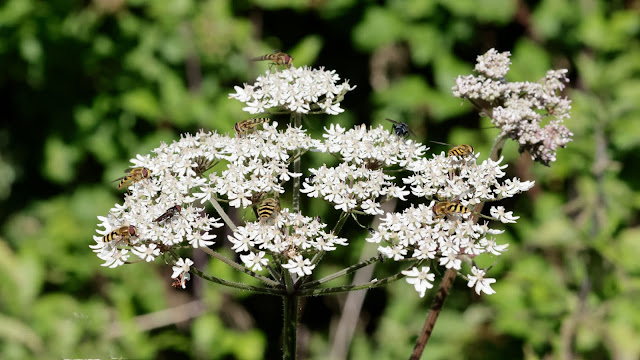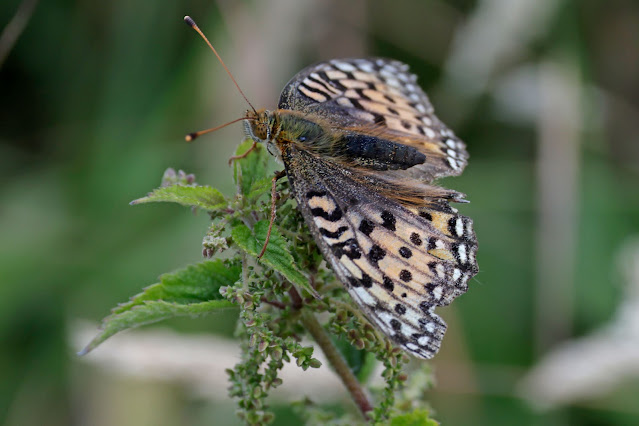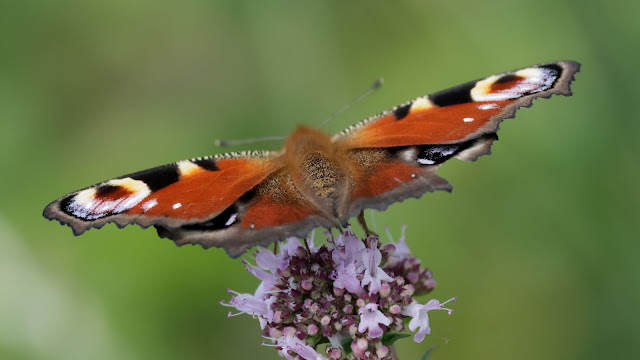The third recorded heatwave of the year was just around the corner and today felt a lot warmer than the previous fresher days. So in my wisdom I decided to visit Old Winchester Hill. There had been reports of Quail calling there the day before and it was a lot closer to go here than to drive all the way to Martin Down, where several have been heard and even seen.
Leaving the car park I walked along the top path and coming out of the tree tunnel was amazed to find a Beautiful Demoiselle on the leaves of a hazel tree.
There were plenty of butterflies amongst the grasses where there was als a good amount of Field Scabious. It was mostly large and Small Whites on the wing, but amongst them was a Red Admiral and a single male Brimstone.
At the bramble bushes a lot of the flowers have now gone over, but where there were still flowers they were attracting quite a few Peacock and Comma and amongst these was a single Painted Lady.
On the edge of the path was a Large Skipper.
I walked around the top path to the fort, listening out for Quail, without any luck. I decided to walk down the south slope. This is the best site for Silver Spotted Skippers, normally a late emerging butterfly, being seen in early August, but everything this year has been early so I was hopeful.
The ground was very dry and the grasses very yellow. There was quite a bit of Field Scabious in flower and this was attracting the white butterflies once again. It was also nice to still see good numbers of Marbled Whites.
A Large White on Field Scabious
On reaching the bottom of the slope the Chalkhill Blues appeared. Some of the females were searching the grass to lay eggs, while the males whizzed around chasing each other and nectaring on the flowering thyme.
I also managed to find a Common Blue.
Unfortunately there were no Silver spotted Skippers, still a little too early maybe. However what was encouraging was the amount of Ground Thistle flowering, a food plant of the skipper.
I walked to the top of the hill and then up on to the fort wall. The breeze was very welcome as it was now quite hot.
The view here is spectacular every visit and I thought I would celebrate it today with some nice black and white photographs.
Walking around the north side of the fort, there were more butterflies, several Dark-green Fritillaries were zipping about. I think this must be a female as it was crawling about in the grass, maybe to lay eggs?
A little further along a lovely Marbled White had settled on a Field Scabious and despite the breeze continued to nectar.
Some orange movement caught my eye on the slope and it turned out to be a Small Tortoiseshell.
Everyone I have seen this year has either been here at Old Winchester Hill or on the other side of the valley at Beacon Hill.
Another Dark Green Fritillary, a little faded and resting on a nettle.
I sat on the bench at the entrance to the fort to eat my lunch and was entertained as a pair of Raven flew over calling to each other.
I walked the slopes and was rewarded with a very nice Red Admiral.
I debated whether to walk back along the top path or tke the slopes. I went for the slopes, in this heat I must have been mad!
All the butterfly action was at the bottom of the hill before the entrance to the copse. A large Skipper
And a nice male Brown Argus.
Walking through the wood there was a Peacock sunning itself on an old log. The second brood of this species appears to be doing very well.
Coming out of the wood it was quite quiet, only a few butterflies along the path. A surprise was this Small Copper on the path being one of them.
Then the sun came out and this Dark Green Fritillary appeared, looking for suitable plants to sit on while avoiding the attacks from Meadow Browns
Walking up the slope there were plenty more Peacock nectaring on the thyme.
One final black and white view before the steep climb back to the car park.
A visit of just over two and a half hours produced twenty two butterfly species, the best daily record of the year so far.






















































